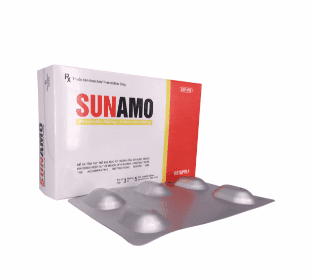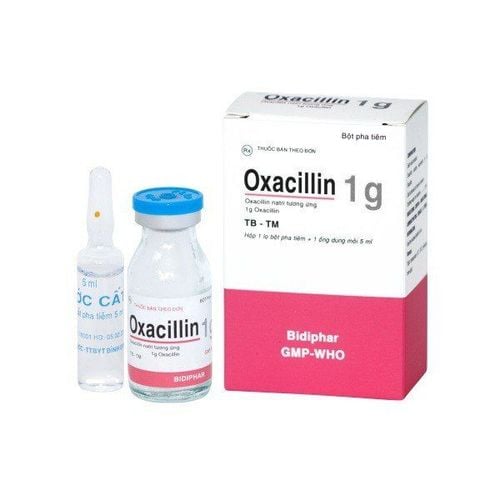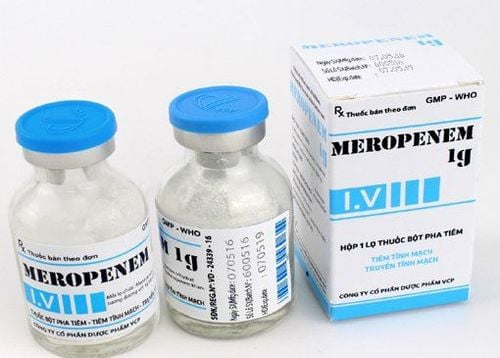This is an automatically translated article.
Cefabact belongs to the group of anti-parasitic, anti-fungal, anti-viral and anti-infective drugs. What are the specific uses and dosages of the drug and who should take it? All information will be answered in the following article.1. Uses of Cefabact
Cefabact drug contains the main ingredient is Cefotaxime and is indicated for use in cases of serious and critical infections such as: brain abscess, endocarditis, sepsis, pneumonia, injury typhoid, severe intra-abdominal infections (in combination with metronidazole), gonorrhea, meningitis (except meningitis caused by Listeria Monocytogenes), typhoid. The drug is applied to prevent infection after laparoscopic surgery, prostate surgery, cesarean section.
2. Cases of not using Cefabact
Do not use for people who are allergic or sensitive to Cefotaxime and other ingredients of the drug or cephalosporin antibiotics.
3. Notes when using Cefabact
Before being prescribed the drug, the patient needs to tell the doctor about the history of disease or allergies. For example with penicillins, cephalosporins or other drugs. About 5 - 10% have cross-allergic reactions between penicillins and cephalosporins, so caution should be exercised when using Cefotaxime in patients who are allergic to penicillin.
In case of co-administration with potentially nephrotoxic drugs such as aminoglycosides, renal function should be monitored. Note the dose reduction for people with severe renal impairment.
When using Cefotaxime can cause false positive with Coombs test, tests of urinary tract, reducing agent without using enzyme method.
Similar to other antibiotics, if Cefbact is used for a long time, there is a risk of overgrowth of non-susceptible bacteria such as Enterococcus Candida, Pseudomonas aeruginosa or the risk of causing pseudomembranous enterocolitis caused by Clostridium difficile.
Note when using this drug with people with a history of seizures. In case of convulsion, the patient should stop taking the drug and go to the nearest medical facility for symptomatic treatment of the convulsion.
Cefabact has not had specific research results on safety for pregnant women. However, the drug crosses the placenta during the second trimester of pregnancy, so pregnant women should not take it during this time.
Do not use the drug when driving or operating machinery because Cefotaxime can cause dizziness, headache.
4. Unwanted side effects when using Cefabact
Common cases:
For the digestive system can cause diarrhea May appear pain and inflammatory reaction at the site of intramuscular injection, thrombophlebitis at the injection site; Rare cases:
For the circulatory system, there is a risk of general leukopenia or eosinophilia resulting in a positive Coombs test; For the digestive system, it will change the bacteria in the intestine, being superinfected by drug-resistant bacteria such as Pseudomonas aeruginosa, Enterobacter spp...; Rare cases:
Hypersensitivity reactions, anaphylaxis; For the digestive system causing colitis associated with Clostridium difficile; Increased bilirubin and liver enzymes; Causes headache, dizziness.
5. Dosage and use of Cefabact
Cefabact is prepared in powder form for injection, so it will be absorbed into the body through deep intramuscular injection or injection / intravenous infusion (3 - 5 minutes injection, 20 - 60 minutes infusion)
Instructions for solution preparation :
Intramuscular injection: use 3ml of water for injection into a vial containing 1g of Cefotaxime; Intravenous injection: use 10ml of water for injection into a vial containing 1g of Cefotaxime; Intravenous infusion: Reconstituted solution of Cefotaxime to be mixed with 50 ml of 0.9% sodium chloride injection solution. Recommended dosage:
Adults: 2 - 6g per day divided into 2 or 3 times. In severe infections, the dose may be increased to 12g/day. Intravenous infusion divided into 3 to 6 times. The usual dose when infected with Pseudomonas aeruginosa is over 6g/day (note that ceftazidime has a stronger effect against blue pus bacilli); Children: use 100 - 150 mg/kg body weight (infants are 50 mg/kg body weight) divided into 2 - 4 times daily. In some cases, the dose may be increased to 200 mg/kg in children and from 100 to 150 mg/kg in neonates. Above is all the important information about Cefabact. Before using, patients should carefully read the instructions before use to get the best treatment results.
Please dial HOTLINE for more information or register for an appointment HERE. Download MyVinmec app to make appointments faster and to manage your bookings easily.













